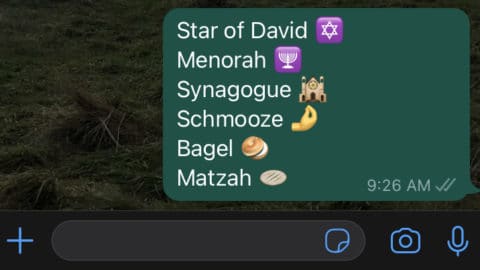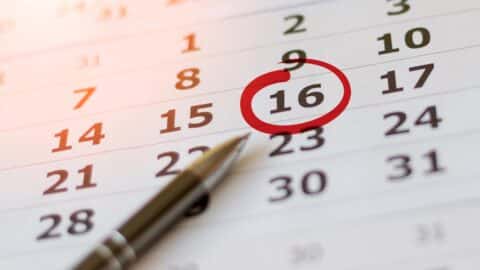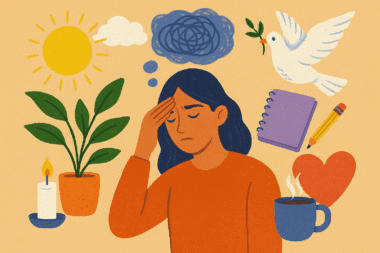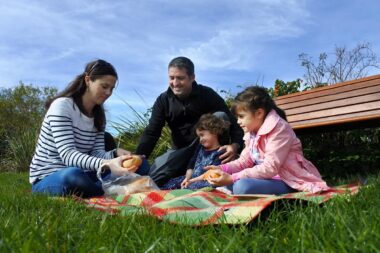The moment has arrived: Rosh Hashanah, the Jewish New Year! But don’t grab your party horns or those plastic glasses that spell out the year just yet. The Jewish New Year isn’t about raucous celebration — it’s about deep introspection and preparing for a year filled with goodness, holiness, and meaning.
For many of us, sitting in a synagogue for hours doesn’t always feel like a spiritual experience. Much of that comes from the fact that Rosh Hashanah services are long and complex. It can be hard to connect with them if you don’t know what’s happening.
That’s why today we’re unpacking the Rosh Hashanah service and offering insights on how to make this year’s experience more meaningful.
What is Rosh Hashanah?
Rosh Hashanah marks the first day of the Jewish calendar. The holiday lasts two full days, from sundown to nightfall (this year, Monday, September 22, through Wednesday, September 24). Around the world, Jews celebrate with three main traditions: attending services, sharing festive meals, and listening to the sound of the shofar, a ram’s horn used as a sacred instrument in Jewish tradition. Its piercing sound is meant to awaken the spirit and call people to reflection and renewal.
Rosh Hashanah Services
Like other Jewish holidays, Rosh Hashanah follows a set prayer structure:
- Maariv (evening service): A shorter prayer service that includes the Shema — Judaism’s central declaration of faith in one God — and the Amidah, a series of blessings recited while standing, considered the core of Jewish prayer. Both include a few special additions for the holiday.
- Shacharit (morning service): A longer service that features introductory prayers, psalms, the Shema, the Amidah, and a Torah reading.
- Musaf (additional service): A special service focused on the themes of Rosh Hashanah, highlighted by the blowing of the shofar.
- Mincha (afternoon service): A brief service centered mainly on the Amidah
All in all, there’s a lot of praying. Some people spend 10–12 hours in synagogue over the two days. That’s not for everyone — but even if you don’t attend every service, there’s meaning to be found in the parts you do.
Here are a few things to think about:
- Jews have been reciting these prayers for hundreds — if not thousands — of years. What might your parents, grandparents, and great-grandparents have been thinking as they read these same words? What do you hope your children or grandchildren will think when they say them one day?
- Over the course of Rosh Hashanah, we read about the birth and life of Isaac, the son of Abraham and Sarah. On the first day, we hear the story of Abraham and Sarah’s hospitality and how their kindness was rewarded with the miraculous birth of a child in their old age. On the second day, we encounter the troubling story of the Binding of Isaac, when God seemingly commands Abraham to sacrifice his long-awaited son. Reflect on your own life this year: What is something you’ve been waiting for? How did it feel if you finally received it? If you’re still waiting, how can you hold onto hope in the meantime?
A Note on Musaf
During most of the year, the Musaf service is a short add-on prayer said on Shabbat and holiday mornings after the Torah reading. It usually recalls the sacrifices once offered in the Temple on that day. But on Rosh Hashanah and Yom Kippur, Musaf takes on a completely different character.
As Cantor Matt Axelrod explains:
“The Musaf service, usually more of an afterthought throughout the year, completely dominates the High Holiday liturgy. It is long, complex, and serves as the service’s centerpiece. It is here that we find the most iconic prayers: the cantor’s Hineni where [they] plead to be worthy to lead the congregation in prayer; Unetaneh Tokef, the prayer which includes the well-known and haunting passage “Who Shall Live and Who Shall Die” and the “Great Aleinu” during which the cantor lies prostrate in front of the ark in utter supplication. These are moments of incredible drama and emotion.”
The general outline is as follows:
After the three introductory blessings similar to the rest of the year, we get to the heart of Musaf. Cantor Axelrod explains,
After the three introductory blessings (similar to the rest of the year), we arrive at the heart of the service.
Musaf is divided into three central themes:
- Malchuyot (God as Sovereign)
- Zichronot (God remembers)
- Shofarot (God and Revelation)
Cantor Axelrod notes:
“Each of these sections — Malchuyot, Zichronot, and Shofarot — has an identical structure, beginning with an introductory text followed by exactly 10 Biblical verses that help to illustrate the particular theme. These 10 verses all follow the same pattern: There are three from the Torah, three from the Writings, three from the Prophets, and then one more from the Torah — all of which incorporate the same Hebrew roots that define that section.”
Following these three sections, the service concludes with the traditional blessings for worship, thanksgiving, and peace.
The Musaf service is definitely worth reading through before going to shul. Here are a few resources to unpack it in preparation for the big day.
- Rosh Hashanah Musaf: A Call to Change Your Life by Cantor Matt Axelrod
- The Musaf Prayer of Rosh Hashana by Rabbi Yosef Zvi Rimon
- The Rosh Hashanah Prayers: Malchiyot, Zichronot and Shofrot by Rabbi Yehuda Shuprin
The festive meal
For many people, the highlight of Rosh Hashanah is the festive meals held each night of the holiday. At the table, we sanctify the holiness of the day and bless the new year by partaking in special simanim (signs).
Simanim are symbolic foods — fruits, vegetables, and other dishes — that represent our hopes for the coming year. A few classic examples include:
- Apple dipped in honey (that we should have a good and sweet year)
- Pomegranate (that our merits increase, as the seeds of the pomegranate)
- Head of a fish or a sheep (that we should be as a head and not a tail, leading rather than following)
- Beets (that our adversaries be removed — the Hebrew word for beet, selek, is related to yisalek, “to remove”)
Many families also invent playful new simanim. A popular one is celery with raisins to symbolize a “raise in salary.”
Here are a few things to think about:
- What is something you are hoping for in the coming year? What siman could you create to represent that?
- What is the importance of symbols in the first place? Why not just ask for these things directly?
Hearing the shofar
The highlight of Rosh Hashanah is the blowing of the shofar, a ram’s horn sounded each morning in synagogues around the world.
As we mentioned before, various reasons are given for the shofar, Rav Saadia Gaon taught that the shofar recalls key moments in Jewish history: the revelation at Mount Sinai, “On the third day, as morning dawned, there was thunder, and lightning, and a dense cloud upon the mountain, and a very loud blast of the horn [shofar]; and all the people who were in the camp trembled.” (Ex. 19:16) and the Binding of Isaac (Gen. 22), when Abraham offered a ram in place of his son.
Maimonides writes (Laws of Repentance 3:4), ״It is as if [the shofar’s call] is saying:
Wake up, you sleepy ones from your sleep, and you who slumber, arise. Inspect your deeds, repent.״
Another interpretation is that the shofar’s cry resembles the wailing of someone in pain. Its raw sound calls us to pour out our hearts and say: “This is me. Here I am with all my broken parts and mistakes. I’m sorry, and I want to be better.”
As the contemporary Rabbi Shmuel Bornsztain wrote, “And the content of the blowing of the shofar is a broken heart — moaning, wailing, like sick people moan or like one wails about his dead. And that is that a person sees himself as if his powers have already disappeared due to his sickness, or as if he has already died and has no hope. But behold, he is purified by the breaking of his heart, like the matter of a clay vessel, which is purified by breaking it.”
Here are a few things to think about:
- Looking back at the past year: What do you regret? What do you appreciate? What do you want to carry forward?
- What is one change you hope to make this year? What steps will help you follow through?
- If you could broadcast a message to the entire Jewish people, what would you say?
Have a sweet new year and a meaningful Rosh Hashanah!








